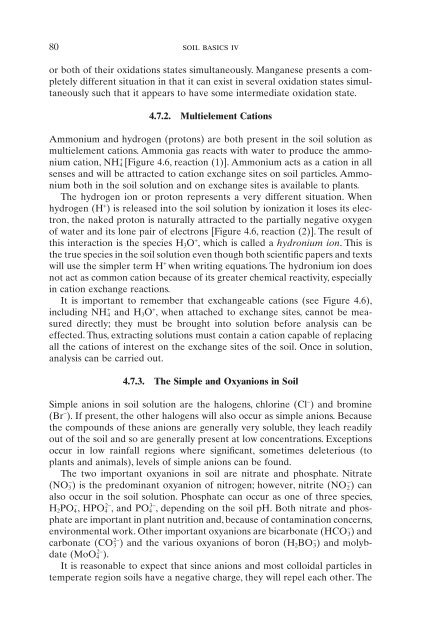Introduction to Soil Chemistry
Introduction to Soil Chemistry
Introduction to Soil Chemistry
You also want an ePaper? Increase the reach of your titles
YUMPU automatically turns print PDFs into web optimized ePapers that Google loves.
80 soil basics iv<br />
or both of their oxidations states simultaneously. Manganese presents a completely<br />
different situation in that it can exist in several oxidation states simultaneously<br />
such that it appears <strong>to</strong> have some intermediate oxidation state.<br />
4.7.2. Multielement Cations<br />
Ammonium and hydrogen (pro<strong>to</strong>ns) are both present in the soil solution as<br />
multielement cations. Ammonia gas reacts with water <strong>to</strong> produce the ammonium<br />
cation, NH4 + [Figure 4.6, reaction (1)]. Ammonium acts as a cation in all<br />
senses and will be attracted <strong>to</strong> cation exchange sites on soil particles. Ammonium<br />
both in the soil solution and on exchange sites is available <strong>to</strong> plants.<br />
The hydrogen ion or pro<strong>to</strong>n represents a very different situation. When<br />
hydrogen (H + ) is released in<strong>to</strong> the soil solution by ionization it loses its electron,<br />
the naked pro<strong>to</strong>n is naturally attracted <strong>to</strong> the partially negative oxygen<br />
of water and its lone pair of electrons [Figure 4.6, reaction (2)]. The result of<br />
this interaction is the species H 3O + , which is called a hydronium ion. This is<br />
the true species in the soil solution even though both scientific papers and texts<br />
will use the simpler term H + when writing equations. The hydronium ion does<br />
not act as common cation because of its greater chemical reactivity, especially<br />
in cation exchange reactions.<br />
It is important <strong>to</strong> remember that exchangeable cations (see Figure 4.6),<br />
including NH 4 + and H3O + , when attached <strong>to</strong> exchange sites, cannot be measured<br />
directly; they must be brought in<strong>to</strong> solution before analysis can be<br />
effected. Thus, extracting solutions must contain a cation capable of replacing<br />
all the cations of interest on the exchange sites of the soil. Once in solution,<br />
analysis can be carried out.<br />
4.7.3. The Simple and Oxyanions in <strong>Soil</strong><br />
Simple anions in soil solution are the halogens, chlorine (Cl - ) and bromine<br />
(Br - ). If present, the other halogens will also occur as simple anions. Because<br />
the compounds of these anions are generally very soluble, they leach readily<br />
out of the soil and so are generally present at low concentrations. Exceptions<br />
occur in low rainfall regions where significant, sometimes deleterious (<strong>to</strong><br />
plants and animals), levels of simple anions can be found.<br />
The two important oxyanions in soil are nitrate and phosphate. Nitrate<br />
(NO 3 - ) is the predominant oxyanion of nitrogen; however, nitrite (NO2 - ) can<br />
also occur in the soil solution. Phosphate can occur as one of three species,<br />
H 2PO 4 - , HPO4 2- , and PO4 3- , depending on the soil pH. Both nitrate and phosphate<br />
are important in plant nutrition and, because of contamination concerns,<br />
environmental work. Other important oxyanions are bicarbonate (HCO 3 - ) and<br />
carbonate (CO 3 2- ) and the various oxyanions of boron (H2BO3 - ) and molybdate<br />
(MoO4 2- ).<br />
It is reasonable <strong>to</strong> expect that since anions and most colloidal particles in<br />
temperate region soils have a negative charge, they will repel each other. The
















